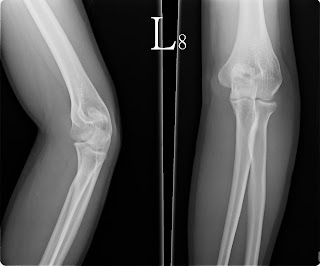
The ulna greater sigmoid notch is all covered by articular cartilage except for a central transverse ridge known as bare area. The radial head is a secondary stabilizer against valgus and posterolateral rotational forces, it articulates with the ulna at the lesser sigmoid notch forming the proximal radioulnar joint. The medial collateral ligament, particularly the anterior bundle, is a primary constraint to valgus stress and the lateral ulnar collateral ligament resists varus stress and acts to prevent rotatory translation. Both the olecranon and coronoid are elbow bony stabilizers, the olecranon prevents anterior displacement of the ulna relative to the distal humerus and the coronoid acts as a buttress to prevent posterior axial ulna translation. Together with the coronoid process the olecranon creates the greater sigmoid notch of the ulna which articulates with the humeral trochlea allowing movement only in the flexion extension axis being therefore crucial for elbow range of motion and intrinsic stability. Elbow stability is provided by osseous congruity and the surrounding soft tissues. The elbow is a trochoid joint that consists of three articulations: The proximal radioulnar, the radiocapitellar, and the ulnotrochlear joints. To correctly treat olecranon fractures we must understand its place in the proximal ulna anatomy and its importance in the normal elbow biomechanics. Most olecranon fractures are associated with good outcome, nevertheless some frequent complications can be anticipated as extension deficit, hardware irritation, and wound healing problems. Combination of the two mechanisms, especially in high energy trauma, can result in the less frequent trans-olecranon fracture dislocation which is usually associated with concomitant bony and soft tissue elbow injuries. Injury mechanism can be a direct fall over the olecranon, which results in impaction of the olecranon against the distal humerus resulting in a comminuted fracture or a sudden eccentric triceps contraction upon a flexed elbow of a falling upper extremity, which typically results in a simple transverse or oblique fracture. There is a variety of fixation techniques, however no technique is suitable for the management of all olecranon fractures and each one is associated with more or less prevalence of the most common complications. Olecranon fracture is a common injury, representing 8-10% of all elbow fractures, it's an intra-articular fracture and can cause disruption of the elbow extensor mechanism, therefore most of these fractures are treated surgically. Olecranon fractures, Complications, Functional outcomes For a better understanding and treatment of this fracture the elbow relevant anatomy and olecranon fracture morphology are also reviewed. This article reviews the treatment of olecranon fractures and its complications. Overall final outcomes of olecranon fractures treatment are good, fracture union is the expected outcome regardless the osteosynthesis method and functional outcome is good to excellent in the great majority of patients. Several options exist for olecranon fracture treatment, tension band, plating, intramedullary nail and fragment excision with triceps advancement are the most used but no technique is suitable for the management of all olecranon fractures and each one is associated with more or less prevalence of the most common complications, namely loss of motion, nonunion, malunion, infection, wound dehiscence, instability, symptomatic hardware, ulnar neuritis, posttraumatic arthritis, and heterotopic ossification. Any weakness and stiffness of the elbow after the cast is removed typically resolves within a few weeks or months, but can be treated with physical therapy if needed.Olecranon fractures are common upper extremity fractures usually subject to surgical fixation. Then the pins are removed in clinic when the cast is removed. The most common surgical fixation of the elbow involves pins to hold the fracture in place while it heals in a cast, typically for around 4 weeks. Displaced fractures are either realigned by means of a closed reduction (repositioning the bone without surgery) and subsequently casted, or the fracture is fixed with surgery.

Other types of elbow fractures are treated much like other fractures: non-displaced fractures are treated with a long-arm cast. This is typically treated with a few weeks in a cast or splint. Occult, or “hidden,” fractures of the elbow frequently occur where there is no obvious fracture line on initial x-rays but there is significant swelling. Fractures can involve any of the 3 bones in the elbow joint: the humerus (upper bone of the arm extending from the shoulder to the elbow), the radius (forearm bone that extends from the outside of the elbow to the thumb side of the wrist) and the ulna (other forearm bone extending from the inside of the elbow to the pinky side of the wrist). Elbow fractures are very common in children.


 0 kommentar(er)
0 kommentar(er)
